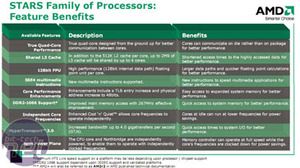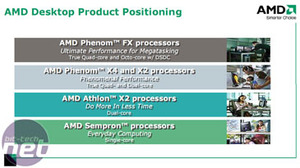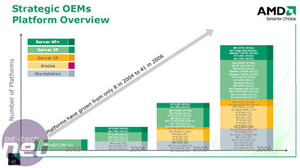
Moving from the CITY to the STARS
AMD's socket AM2 processors were internally referred to as CITIES CPUs, and a socket revision brings a new code name: STARS. Apart from the performance upgrade to HyperTransport 3.0, the advantage of AM2+ is the use of split plane voltages.This provides five dynamic and independent power states for each core, allowing not only per-core clock frequency adjustment like AM2 CPUs, but now per-core voltage adjustments as well. Together, both allow a greater variation in power states and better power management.
AMD stubbornly refused to supply details as to what the five power states are exactly, explaining that further architecture details will be available at a later date.
In addition, the power management update includes more coarse and fine clock gating inside the silicon. Coarse gating allows the processor to shut down entire blocks of logic, while fine gating allows it to shut down subdivisions of logic when appropriate to reduce power usage. After all, why power something up when it's not being used?
However, no information is yet available from AMD with regards to how long it takes to re-power an idle portion of the CPU. Even if it takes just a couple of clock cycles, the cumulative effect of this can mean larger latencies in the CPU if silicon is constantly being stopped and started.
Ideally you want to run AM2+ CPUs in AM2+ sockets to really maximise the performance gain and take advantage of the updated power management features. It is possible to run AM2 CPUs in AM2+ motherboards but they will not use the additional new features. In a similar vein, AM2+ in AM2 motherboards will be restricted to a the older AM2 features, including lower HT speeds and inferior power management.
AM3 should arrive next year and bring with it a whole new socket for DDR3, in addition to the new features included in AM2+.
Even though official announcements are yet to arrive, the news through the grapevine is that the FX series will yet again be moved to Socket F, while the rest of the range exists in the AM2+ socket with varying clock and HyperTransport speeds permeating down the range.
Originally AMD released its FX processors on socket 940, which required registered ECC memory compared to the more popular and widely supported socket 939 which used cheaper unbuffered DDR. A different socket for its FX range didn’t work then and there’s no reason it should work now, so why hasn't AMD learnt?
Final Thoughts
If you're interested in servers with multi-core, multi-CPU performance, when samples finally arrive (after this paper launch) for quad core Opterons they should provide a ton of extra performance in the same amount of space, while rivalling Intel's current and future Xeon offerings.If you're still swaying towards Xeons, not having to worry about buying expensive FB-DIMMs for starters should be enough to hold off in itself. AMDs proven HyperTransport solution should continue to scale perfectly as you add more CPUs, compared to Intel's single MCH Xeon platform.
On the Phenom front, things aren't so rosy as this won't arrive until Q3 (next month at the earliest). However, since Phenom is only tipped for the high end and the cheaper X2 variants are due even later in Q4 of this year, this means that Intel will continue to hold the price to performance crown for the majority of users, unless AMD can deliver a very attractively priced Phenom X4. The playing field has almost entirely changed, especially since Intel's value 2100-series processors was recently released, with chips costing as little as £50 (inc VAT).
These, along with the low-mid range Core 2 Duos, should continue to obliterate Athlon 64 X2 or Sempron offerings. It will be interesting to see how AMD reacts, perhaps with further price cuts. That won't benefit the companies shaky bottom line, but it'll certainly benefit the consumer either way.
It still looks like AMD has something exceptionally powerful on paper, and finally a true competitor to Intel's Core as we peer through the glass, nose pressed against the surface, but until we get hold of one to test all bets should remain off. Intel's 1333MHz FSB quad core CPUs and eventually 45nm Penryn are due in a similar short term timeframe. So until the silicon tumbles into place, judgement should be reserved to the realms of fanboys as to who will win the next battle in the CPU war.

MSI MPG Velox 100R Chassis Review
October 14 2021 | 15:04












Want to comment? Please log in.